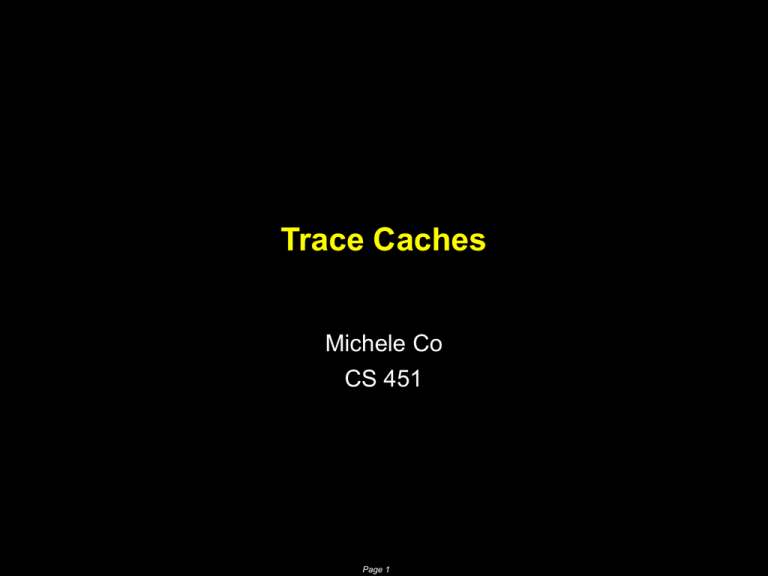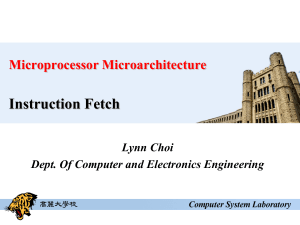Trace Caches
advertisement

Trace Caches Michele Co CS 451 Page 1 Motivation High performance superscalar processors High instruction throughput Exploit ILP –Wider dispatch and issue paths Execution units designed for high parallelism –Many functional units –Large issue buffers –Many physical registers Fetch bandwidth becomes performance bottleneck Page 2 Fetch Performance Limiters Cache hit rate Branch prediction accuracy Branch throughput Need to predict more than one branch per cycle Non-contiguous instruction alignment Fetch unit latency Page 3 Problems with Traditional Instruction Cache Contain instructions in compiled order Works well for sequential code with little branching, or code with large basic blocks Page 4 Suggested Solutions Multiple branch target address prediction Branch address cache (1993, Yeh, Marr, Patt) – Provides quick access to multiple target addresses – Disadvantages • Complex alignment network, additional latency Page 5 Suggested Solutions (cont’d) Collapsing buffer Multiple accesses to btb (1995, Conte, Mills, Menezes, Patel) – Allows fetching nonadjacent cache lines – Disadvantages • Bank conflicts • Poor scalability for interblock branches • Significant logic added before and after instruction cache Fill unit Caches RISC-like instructions derived from CISC instruction stream (1988, Melvin, Shebanow, Patt) Page 6 Problems with Prior Approaches Need to generate pointers for all noncontiguous instruction blocks BEFORE fetching can begin Extra stages, additional latency Complex alignment network necessary Multiple simultaneous access to instruction cache Multiporting is expensive Sequencing Additional stages, additional latency Page 7 Potential Solution – Trace Cache Rotenberg, Bennett, Smith (1996) Advantages Caches dynamic instruction sequences –Fetches past multiple branches No additional fetch unit latency Disadvantages Redundant instruction storage –Between trace cache and instruction cache –Within trace cache Page 8 Trace Cache Details Trace Sequence of instructions potentially containing branches and their targets Terminate on branches with indeterminate number of targets –Returns, indirect jumps, traps Trace identifier Start address + branch outcomes Trace cache line Valid bit Tag Branch flags Branch mask Trace fall-through address Trace target address Page 9 Page 10 Next Trace Prediction (NTP) History register Correlating table Secondary Table Complex history indexing Indexed by most recently committed trace ID Index generating function Page 11 NTP Index Generation Page 12 Return History Stack Page 13 Trace Cache vs. Existing Techniques Page 14 Trace Cache Optimizations Performance Partial matching [Friendly, Patel, Patt (1997)] Inactive issue [Friendly, Patel, Patt (1997)] Trace preconstruction [Jacobson, Smith (2000)] Power Sequential access trace cache [Hu, et al., (2002)] Dynamic direction prediction based trace cache [Hu, et al., (2003)] Micro-operation cache [Solomon, et al., 2003] Page 15 Trace Processors Trace Processor Architecture Processing elements (PE) – Trace-sized instruction buffer – Multiple dedicated functional units – Local register file – Copy of global register file Use hierarchy to distribute execution resources Addresses superscalar processor issues Complexity – Simplified multiple branch prediction (next trace prediction) – Elimination of local dependence checking (local register file) – Decentralized instruction issue and result bypass logic Architectural limitations – Reduced bandwidth pressure on global register file (local register files) Page 16 Trace Processor Page 17 Trace Cache Variations Block-based trace cache (BBTC) Black, Rychlik, Shen (1999) Less storage capacity needed Page 18 Trace Table: BBTC Trace Prediction Page 19 Block Cache Page 20 Rename Table Page 21 BBTC Optimization Completion time multiple branch prediction (Rakvic, et al., 2000) Improvement over trace table predictions Page 22 Tree-based Multiple Branch Prediction Page 23 Tree-PHT Page 24 Tree-PHT Update Page 25 Trace Cache Variations (cont’d) Software trace cache Ramirez, Larriba-Pey, Navarro, Torrellas (1999) Profile-directed code reordering to maximize sequentiality –Convert taken branches to not-taken –Move unused basic blocks out of execution path –Inline frequent basic blocks –Map most popular traces to reserved area of i-cache Page 26










